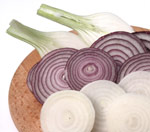The Power of Red Onions

(NaturalNews) Onions are one of the most popular vegetables worldwide. While most children dislike their pungent and bitey flavor, most adults embrace and use them regularly. Red onions contain twice as many anti-oxidants as any other form of onion, making them a powerful part of an anti-inflammatory diet and lifestyle.
Red onions get their bite from the many sulfur groups they contain. These sulfur groups include the diallyl sulfides: DMS, DDS, DTS & DTTS. These sulfur groups help produce cysteine within the body that aids in weight loss and detoxification. Additional research has shown that sulfur compounds have a strong anti-capacity that inhibits blood cell clumping.
The sulfur compounds in red onions also lower LDL cholesterol & triglycerides while boosting HDL levels. They are associated with improving cell membrane function in red blood cells and improving oxygen utilization. This improves cardiovascular function as well as fat metabolism.
Rich in Anti-Oxidant PhytoNutrients
Red onions are also a rich source of the flavonoid anti-oxidant quercetin and the polyphenol anti-oxidant anthocyanin. These anti-oxidants prevent the oxidation of dietary and cellular fatty acids. They are very powerful free radical scavengers that neutralize cancer cell growth and dramatically reduce whole body inflammation.Studies have shown that consuming quercetin from onions was much more effective than taking quercetin extracts in supplement form. The body is able to better recognize the nutrient when it is in a natural form and has other synergistic components associated with it.
Red onions are also a fantastic source of chromium which lowers blood sugar and enhances cellular insulin sensitivity. Nearly 50% of the US population is deficient in chromium which is greater than any other developed nation. This is due to over cropping that has stripped the land of chromium and processed food consumption. Chromium deficiencies lead to diabetes and heart disease.
The anti-oxidant flavonoids are extremely rich in the outer layers of the onion. Many people will peel off the first few layers and lose much of these critical nutrients. Be sure to utilize the outer, fleshy edible portions as much as possible. Overpeeling, by taking off the outer 2 layers of flesh will cost one about 20% of its quercetin and over 75% of its anthocyanins.
Simmering onions in a soup or broth will damage some of the anthocyanins but not the quercetin. The quercetin moves into the soup or broth. The lower the heat the more nutrients will be contained in the soup or broth.
Studies have shown that 4-7 servings of red onions each week (equivalent to about 2-3 onions) has been associated with the greatest benefit in reducing colorectal, oral, laryngeal, esophageal & ovarian cancer.
Red onions should be stored in a cool, dry area with good airflow. Until they are opened they should not be stored in a refrigerator or plastic bag as both of these have been shown to speed up spoilage. Once opened, it is best to store in refrigeration. Avoid any onions that are wet, soft, bruised or have dark spots or mold on them.
Sources for this article include:
http://www.whfoods.com/genpage.php?tname=foodspice&dbid=45
http://www.drweil.com/drw/u/ART02868/chromium.html
http://www.produceoasis.com/Items_folder/Vegetables/RedOnion.html
Comments
Post a Comment